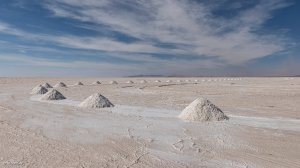Benchmark downplays investor fears of looming lithium oversupply, subsequent price crash
VANCOUVER (miningweekly.com) – London-based Benchmark Mineral Intelligence has downplayed top-level investor fears this week regarding the potential for lithium market oversupply and an inevitable price crash to follow.
The energy metals-focused research company pointed out that rumours about up to 180 000 t/y of added lithium carbonate equivalent (LCE) units coming on line in China over the next 12 months are probably unfounded, and probably at best in the region of 100 000 t/y of new conversion capacity, only by the end of 2019.
However, China's spodumene conversion capacity has been climbing rapidly in recent years. According to senior analyst Andy Miller, China boasts about 200 000 t/y of total LCE conversion capacity, but noted that in reality, it only ever uses about 140 000 t/y of capacity. Further, not all of the capacity has the ability to produce battery-grade lithium chemicals.
Benchmark estimates that Chinese converters produced about 120 000 t of LCE in 2017, up from only 85 000 t of LCE in 2016.
"Benchmark discounts a large proportion of this new capacity as hearsay and conjecture. Historically, the installed nameplate capacity of many Chinese facilities has been much higher than their actual output levels," Miller said in a research note.
The high-quality converters Benchmark tracks are "few and far between", and include the lithium majors such as Ganfeng Lithium, Sichuan Tianqi and Albemarle's GRM.
However, bottlenecks in the supply chain from spodumene to battery-grade chemicals have become apparent the further downstream one looks, such as the manufacture of lithium chemicals, battery-grade chemicals and cathode manufacturing.
"As spodumene players tie in conversion partnerships, it's critically important to ask who is converting this material and if they can reach specification for battery makers. Just selling to China is not the end of the story, it's just the beginning," Miller stated.
Further, Benchmark waylaid fears of increasing volumes of direct shipped ore entering the production chain, saying it is discounting direct shipping ore (DSO) completely until concrete evidence of this being first processed into spodumene and then into LCE units presents itself.
Meanwhile, the recent deal between Chile's Corfo and producer SQM to increase SQM's extraction licence to 216 000 t/y of LCE to 2025 is good news for a lithium industry post-2021, Benchmark said, noting that until at least then, the status quo would remain.
AUTOMAKERS DEMAND
Benchmark believes the demand pull from the automakers for their lines of electric vehicles (EVs) and hybrids is yet to arrive for lithium.
Toyota Tsusho announced its deal with Orocobre to take a 15% stake in the Argentina-based brine producer to fund a 25 000 t/y expansion to 42 000 t/y of nameplate capacity.
"The new deal is a great boost for Orocobre and a vote of confidence for the Olaroz project that has had its share of criticism. This is simply the next stage of a producer and trader relationship, rather than a decision from the top of Toyota's EV planning tree. Toyota's EV ambitions will crystallise towards the end of 2018 and into 2019," Miller stated.
Benchmark believes the high-profile pursuit for upstream cobalt and lithium resources by automakers has only started. Last year, Volkswagen unsuccessfully tried to secure lithium and cobalt supplies.
"All automakers are now fully aware of the need for secure, long-term lithium supply but none have yet locked in long-term contractual agreements. Their negotiating stance is weakening by the day as more automakers commit tens of billions of dollars to build out their EV production capacity – Ford being the latest, committing $11-billion to build 40 hybrid and pure EVs by 2022.
"Therefore, while this auto speculation aids the upward trajectory of lithium's price curve, it is not yet the defining factor. Real lithium supply and demand – producers selling to cathode manufacturers – is what is driving this price. The auto majors are yet to enter this "real" market," Miller advised, noting that 2018 may indeed be the year to watch out for several lithium auto deals to be struck as the need for long-term supply intensifies.
Meanwhile, two significant energy storage projects were also successfully completed in 2017, pointing to a significant new demand for the battery chemical on a grand scale. This is a trend, Benchmark said, that seems to have snuck up on the lithium industry, who remains laser-focused on EVs.
PRICE CONVERGENCE
The research firm pointed out that one has to keep sight of the fact that battery-grade supplies continue to operate as a niche, speciality industry that is serving a high-spec-end market in lithium-ion batteries. Its analysis has not even discussed the other 50% of supply that serves a variety of growing markets, and how this will impact demand.
"Quite simply, to impact the battery-grade lithium carbonate and lithium hydroxide prices that Benchmark assesses on a monthly basis, battery-grade product has to be produced and sold to cathode and battery makers.
"Producing DSO or even spodumene concentrate and adding it to stockpiles is not creating new LCE supply. Then understanding the conversion capacity in China – what is real versus what is conjecture, what is technical grade versus what is battery grade – is key to understanding how much of this feedstock makes its way into batteries. Only then will you see a price correction on the global price averages. Under the most likely scenario, we can see the prices of Chinese lithium chemicals and rest of the world prices converging," the analyst said.
While Chinese lithium carbonate and hydroxide prices have been high for some time and the rest of the world has been playing catch up, the 41% difference between the highest-priced grade (converted material within China) and the lowest price grade (brine sourced European hydroxide) is $6 600/kg, creating room for prices to converge, and the overall global weighted average price to carry on rising.
Comments
Press Office
Announcements
What's On
Subscribe to improve your user experience...
Option 1 (equivalent of R125 a month):
Receive a weekly copy of Creamer Media's Engineering News & Mining Weekly magazine
(print copy for those in South Africa and e-magazine for those outside of South Africa)
Receive daily email newsletters
Access to full search results
Access archive of magazine back copies
Access to Projects in Progress
Access to ONE Research Report of your choice in PDF format
Option 2 (equivalent of R375 a month):
All benefits from Option 1
PLUS
Access to Creamer Media's Research Channel Africa for ALL Research Reports, in PDF format, on various industrial and mining sectors
including Electricity; Water; Energy Transition; Hydrogen; Roads, Rail and Ports; Coal; Gold; Platinum; Battery Metals; etc.
Already a subscriber?
Forgotten your password?
Receive weekly copy of Creamer Media's Engineering News & Mining Weekly magazine (print copy for those in South Africa and e-magazine for those outside of South Africa)
➕
Recieve daily email newsletters
➕
Access to full search results
➕
Access archive of magazine back copies
➕
Access to Projects in Progress
➕
Access to ONE Research Report of your choice in PDF format
RESEARCH CHANNEL AFRICA
R4500 (equivalent of R375 a month)
SUBSCRIBEAll benefits from Option 1
➕
Access to Creamer Media's Research Channel Africa for ALL Research Reports on various industrial and mining sectors, in PDF format, including on:
Electricity
➕
Water
➕
Energy Transition
➕
Hydrogen
➕
Roads, Rail and Ports
➕
Coal
➕
Gold
➕
Platinum
➕
Battery Metals
➕
etc.
Receive all benefits from Option 1 or Option 2 delivered to numerous people at your company
➕
Multiple User names and Passwords for simultaneous log-ins
➕
Intranet integration access to all in your organisation





















